A recent report (voted by “experts”) listed the Top Fifty Vineyards in the World. It seemed more about companies with edifice complexes, than anything to do vineyards, vines, terroir and the people involved in making the wine. The quality of tourist facilities, fanciness of the restaurants, architectural meretriciousness and opulent surroundings were evidently the criteria for inclusion.
Making wine in a cathedral or palace is all very well. Yet there is more glory in wine in a single vineyard micro-organism than in a shiny glass-and-steel visitor centre. Without sensitive farming, wine is an empty vessel. If you’re not working by hand, close to the land, sustainably, organically, preferably biodynamically, making nature your intuitive place of worship, giving birth to something which has its own independent life and a sense of integrity, then you are creating a brand, either something as functional as booze, or a luxury product that consumers aspire to be able to drink, or aspire to own.
The criteria based on this selection of top vineyards are based on certain feelings, in that when you are amongst the vines, you may sense a kind of radiant energy of teeming life and the internal communion of grasses, flowers, insects and birds, Also, you will experience beauty, not tied-up-in-a-ribbon prettiness and primly-mown-grass-between-the-rows beauty, but the beauty of unkempt throbbing elemental nature, wherein the vineyards are a very part of the landscape and the landscape is part of the vineyards (as opposed to being a monoculture).
Listing to the left field
Here are ten from the left field – in no particular order – a personal list of top vineyards. Not only do they ooze charisma, but when you taste the wines you sense the place behind them – even if you’ve never been to that place:
Didier Barral – The Vineyard’s Diet of Worms
Didier Barral is a deeply questing vigneron, a farmer’s farmer, if you like, whose obsession with minutiae forms the bigger picture. Didier owns 35-hectares of biodynamically-farmed vineyards situated in a forest of garrigue on slightly acid schist soils in which a little of everything grows. Everything starts from the soil which must be made as healthy as possible.
“Nowadays, farmers feed the planet but destroy it at the same time. Sometimes they think they are doing the right thing by ploughing too often for example, which eventually damages the soil structure. We have to observe nature and to understand how micro-organisms operate. Then we see that tools and machinery can never replace the natural, gentle work of earthworms, insects and other creatures that travel through a maze of tunnels, creating porosity and aerating the soil, making it permeable and alive. There’s grass in our vineyards and amongst the grass, there are cows and horses: a whole living world that lives together, each dependent on the other and each being vital to the balance of the biotope.” –Didier Barral
This is an extraordinary micro-climate where the mountains on one side and the proximity of the garrigue which shelters fauna and flora create the preconditions for great terroir.
His persuasiveness flows from the stunning beauty of his vines, and from the freshness and purity of his wines. He speaks for himself, and tells his story: one of observation, of trial and error in his vineyards. There is a lot more to the process than can be described here – his views on gobelet vines, the equipment he uses in the vineyards so as not to compact the soils, and of course, the dissertations on worm-life.
Those who visit Domaine Barral are blown away by what they see (and feel). For Tom Lubbe (Matassa) it has been a place of pilgrimage, and after visiting, he feels renewed and inspired to cultivate his own vineyards with the same purpose.
Kelley Fox “Maresh Vineyard” – Volcanic Grace
Kelley Fox feels Maresh vineyard in Oregon’s Dundee Hills on her pulses. It is a special place, as well as being her special place. Her attachment to the vines is almost atavistic, as well as being spiritual, and she gives herself unreservedly to the unique forces animate this small parcel.
The slopes may be moderate and the vines are at no-great altitude, but when you stand in the vineyard you will gaze at a vivid panoramic, with the conical snow-capped peak of Mount Hood in the Cascade Mountains prominent on the horizon. The actual vineyard itself is warm and fertile, the earth a reddish-brown colour and the vines within seem to possess a riotous energy, shooting out suckers with crazy irregularity. You swiftly understand, when you are amongst these vines, that not does only each block have its own particular microclimate, but each row – and even vine – has a distinct personality too.
Kelley moves between the vines, in her own world, touching them, occasionally talking to them, happiest when she is alone and listening to the song of the vineyard. A special place where you may witness the interaction between the vigneronne and the vineyard.
When you taste the Maresh Pinots you understand the intimate relationship between place and wine and how wine subtly captures these almost indefinable nuances of the vineyard and what Kelley calls volcanic energy.
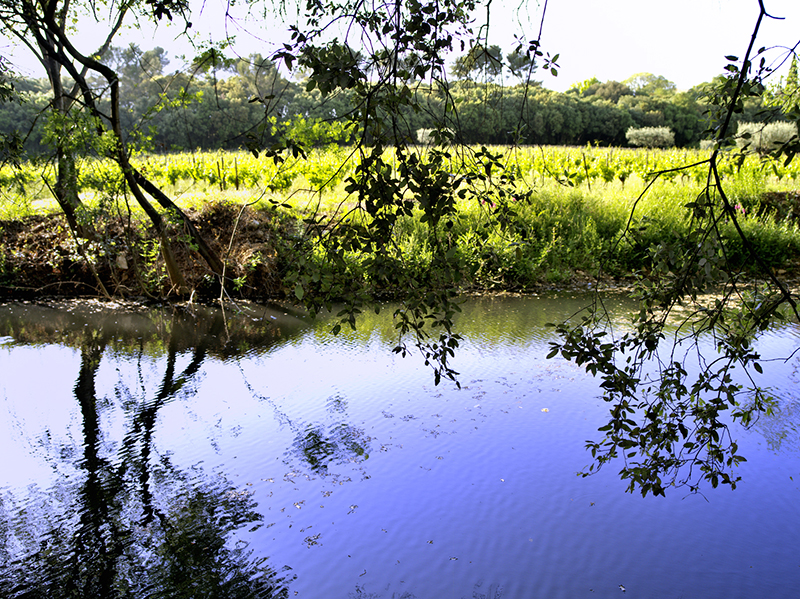
Mas de Daumas-Gassac – Theatre of Vines
Walking up the Gassac hill is an education of the senses. The location is quite beautiful, with small pockets of vines planted in clearings in a natural amphitheatre. You feel like you are in a special place.
When the Guiberts first purchased their farm (the mas) in the charming Gassac valley, they little realised that they had a special micro-climate which would give them the potential to make great wines. A visiting professor from Bordeaux, one Henri Enjalbert, identified a particular red soil that was common to certain great estates in the Médoc and Grand Cru Burgundies. Under the thick garrigue scrub and shrubs covering the Arboussas hills, he found some 40 hectares of perfectly-drained soil, poor in humus and vegetable matter, rich in mineral oxide (iron, copper, gold etc). Formed from deposits carried in by the winds during the Riss, Mindel and Guntz glacial periods (ranging from 180,000 – 400,000 years ago) the terroir provided (and provides) the three elements necessary for a potential Grand Cru: deep soil ensuring the vines’ roots delve deep to seek nourishment; the excellent drainage ensuring the vines’ roots are unaffected by humidity; poor soil meaning that vines have to struggle to survive, an effort which creates exceptionally fine aromas. Rock, scrub and tree clearing began in 1971 and the first vines, principally Cabernet Sauvignon, were planted on the 1.6ha plot.
Mineral-rich soil is only one element in the Gassac cocktail. You only have to stand in the vineyards to engage with the subtleties of the micro-climate. The hill is thick with garrigue; strong warm scents of wild herbs imprint themselves in the air; the quality of light is fantastic. The vines are planted in small clearings, magical glades hidden in the dense, forest-like garrigue. The complexity of Daumas Gassac wines derives heavily from these scents of myriad Mediterranean wild plants and herbs: bay, thyme, rosemary, lavender, laburnum, fennel, wild mint, lentisque, strawberry trees…
It’s all part of the ‘terroir’ effect, that combination of soil, climate and environment that sets one wine apart from another, sadly an effect that is lost in modern monoculture, where huge areas are cleared of all vegetation except vines. At nightfall, the cold air from the Larzac plateau (850 metres) floods into the Gassac valley, with the result that, even in the height of summer, the vineyards benefit from cool nights and moderate daytime temperatures. The northern facing vineyards accentuate the beneficial effect of this cool micro-climate by ensuring they are exposed to less direct sunshine during the hot summers. The micro-climate also means that the vines flower some three weeks later than the Languedoc average which in turn is significant factor in creating the outstanding complexity and finesse of the red wines, most especially the splendidly fine balance of the great vintages’ alcohol-polyphenol-acid content.
Yes, the Gassac valley is an energising place, full of beauty, and reminds one that it is the sacred role of the vigneron to coax the beauty from such an environment into the bottle.
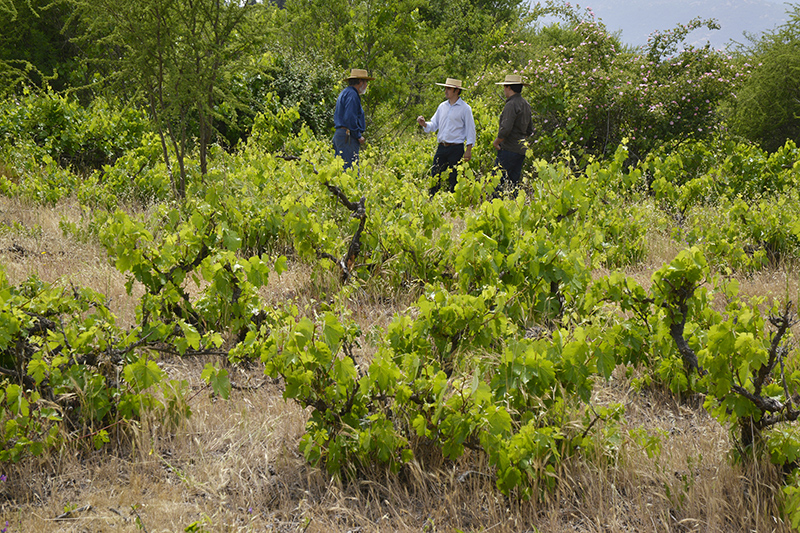
Villalobos – Wild Thing
The Villalobos family estate is located near to the village Ranguili in the Colchagua Valley appellation. Colchagua is a region close to the coast, internationally recognized for its dry summer days and refreshing short nights. The vineyard, in question, if that is not an exaggeration to describe the ragtag of vines thus, is mainly Carignan, originally planted during the 1940s.
Villalobos vines have never been treated as such in the production process; indeed, the vines have always grown wild and free from any chemical processes for seventy years amongst native Chilean flora such as Maitenes, rosehip, Culenes, pine trees, blackberry bushes etc.
The family’s mission is the constant quest to produce a wine characterised by its unique qualities and the special Carignan variety, which almost disappeared from Chile a few years ago. The cellar is in the sculpture workshop of Enrique Villalobos, in the Valley of the Artists. The art of sculpture and the art of wine-making are intrinsically linked in the creation process; that is, the modification and intervention of substances offered by nature, which the artist may turn into a unique and particular work of art. This is holistic winemaking, par excellence.
Given this context, the vineyard wishes to distance itself from the traditional industrial monoculture. The main goal is to produce wines which reflect the seasonal conditions and qualities of the terroir, taking advantage of the organic and wild characteristic of the aged vines. This unique terroir allows grapes to be harvested which give the wine an aroma that is perfectly harmonized with the local countryside.
A little local colour – meandering through the “bush” and tree vines
We stop by the head of a path, walk through a gate and promenade through woods of pine, eucalyptus and local trees until the woods became bushes, snagging brambles, and the ambling became stumbling, scratching a way through twigs, thorns and snappy branches…
Two roads diverged in a yellow wood
And sorry I could not travel both
And be one traveller, long I stood
And looked down one as far as I could
To where it bent in the undergrowth…
Deeper in, treading amongst vines spooled on the ground, seeing grapes pip-to-pip with blackberries and sloes, others enmeshed deep in bramble bushes, whilst other vines climb higgledy-piggledy up tall trees creating a wilderness – a happenstance of vines.
This is beyond organic or biodynamic viticulture. It is a non-cultured vineyard, a tiny part of a greater whole. The philosophy of Villalobos is based on absolute respect for the environment where the grapes are produced. The vineyard operation involves the use of horses and natural forms of herb control in order to keep the natural balance. We learned that harvesting these precious few grapes was back-breaking and risky work. If you are not up a ladder, you are gingerly plucking the odd grape from the scratchy embrace of the bushes, armed with masks and gauntlets to ward off bees, thorns…

Mont Damnés, Domaine Henri Bourgeois – Blessed Damnation
Jutting up dramatically from one side of the hamlet of Chavignol is the Mont-Damnés. Whilst several domaines have precious vines on this hill, the Bourgeois family owns a sizeable chunk of this particular prime wine real estate, the grapes for which go into the MD and Jadis cuvées. Who knows why these Sancerre slopes are damned, but they are certainly damned steep, and Mr Kimmeridge himself would award this vineyard the full five fossils for wearing its mineral composition on the surface.
Not only is the Mont Damnés an impressive-looking ball of chalk, but the activity within the Bourgeois blocks is spot-on, with organic farming and superbly-detailed attention to vines.
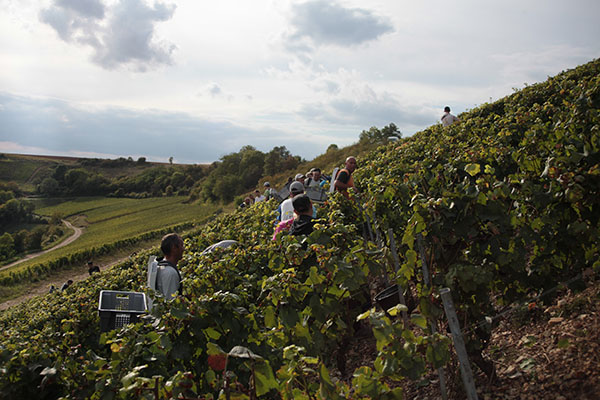
The two wines from here different in several respects. Jadis comes from a parcel of Sauvignon Rose, a Sauvignon mutation where the grapes, when they ripen, acquire a pinkish-grey hue. A wine of great charisma; very aromatic and concentrated from small compacted grape bunches. There is more material to work with and thus a portion of the wine is put in barrels. Complex and well-balanced, Jadis reveals aromas of exotic fruits and honey. The MD, named after the hill, has the more classical Sancerre signature of tangy ripe currant fruit and is a terrific Sancerre in its own right.
Krepskögel, Andreas Tscheppe – Opok Around the Clock
One of the Andreas key vineyards is the south-east facing high altitude Krepskogel. The steep terraces lie 500m above sea level and are surrounded by the thick forests. You are but a hop from Slovenia – indeed one drives across the border to reach the vineyard. The soil is very sparse and dominated by Opok with lots of stones on the surface. The remarkably high mica content is seemingly responsible for the particular graphite scent of the wines.
Farming is biodynamic. Each plant has its place and every living thing is taken into consideration in the belief that the vitality and complexity of the soil are the basis for expressive wines. It is an invigorating place to visit, full of flowers and insects.
Andreas speaks about the dialogue of the earth and the air and one may see the roots of the newly-planted vines here peeking out and being part of the conversation. Small clumps of flowers and weeds thrive in each of the rows.
Strike two stones together and smell. Blue opok – a gunflint aroma, a miniature detonation, the kind of fireworks we smell and taste in the wines.
Here Andreas grows and harvests his grapes for the Green Dragonfly, the Segelfalter (Gelber Muskateller) and Schwalbenschwanz (Golden Muskateller). Close your eyes and smell these wines – light, herbs, flowers, earth and stone captured in the different liquid form.
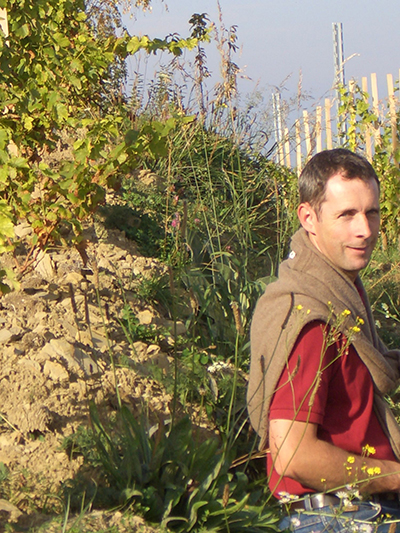
Finca Pombeiros, Guimaro – Sheer Brilliant Folly
The Romans used slave labour to plant terraced vineyards along the Sil and Minho riverbanks. Today, Ribeira Sacra growers still have to work like slaves to prune, tend, and harvest grapes from these improbably situated vines. A few sites, including Cividade, Marcelino, and Viña A Ferreira, are so inaccessible that when the grapes are harvested, they are lowered to boats waiting on the Sil River, brought to landings that can be reached by road, and finally hauled to the wineries. All the vineyards have makeshift rails adapted from mining, with mechanical lifts that are winched up and down, carrying one person at a time, a few tools, and, during harvest, containers of grapes.
Ribeira Sacra is where the men (and women) are truly vital, because the cosecheros (those who tend and harvest the vineyards) must also be capable of what is known as heroic viticulture. It is one of only two areas in Spain (Catalunya’s Priorat is the other) that requires this “heroic viticulture”. The region’s steeply-tiered slate bancales, or terraces, have a great deal to do with why the wines of Ribeira Sacra can be so profoundly terroir-driven, intriguing, and delicious, and why this area has the potential to produce wines as great as those from anywhere in Spain.
Guimaro means rebel in local dialect. Cultivated since Roman times, the steep terraced vineyards are some of the most picturesque and treacherous to work in the world of wine – think Douro, Cote Rotie, or Mosel. Like those most dramatic terruños, winegrowing here is not for the faint of heart; it takes spirited determination, unwieldy optimism, a sense of tradition, and a willingness to collaborate.
This relatively new wine from Guímaro (Finca Pombeiros) comes from a single 0.45 ha plot -facing south – of 70-year-old Mencía vines, planted as high as 450 metres elevation. This is the adega’s only cuvee fermented entirely with whole grape clusters. It sees 8-10 months in used 500-litre French oak barrels. This cuvee is markedly more umami, savory, and earthy in comparison to the other single vineyard cuvées.
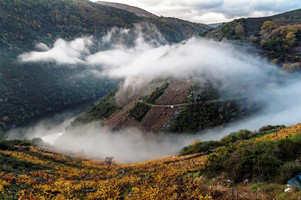
Rumbo el Norte, Comando G – Rumble in the Rocky Mountain Road
Bodega Comando G is made up of Fernando García and Daniel Gómez Jiménez-Landi. They met in 2005 while at university where they forged their friendship based on a mutual passion: making first-rate Garnacha wines, which capture and express the terroir of the unique plots where the grapes are grown. Three years later, in 2008, they launched the G (G for Garnacha) business venture. Although there are some who affectionately call them the ‘enochalados’ (‘crazy oenologists’), in reality, this ‘online cooperative bodega’ (as described by El Mundo Vino) is carrying out the very serious task of searching for old-vine vineyards planted with the Garnacha grape variety in the Sierra de Gredos, located between the provinces of Madrid and Ávila. And the truth is that their work represents an authentic breath of fresh air, both in the winemaking process — extracting the personality from each individual plot.
There are three hectares of old Garnacha vines spread out among the villages of Cadalso de los Vidrios and Rozas de Puerto Real, near the Sierra de Gredos mountains, on granite soil and at an altitude of between 900 and 1,000 metres.
Even by these standards, Rumbo al Norte is at the extreme being a 0.3ha north-facing, plot at 1200 m above sea level of 70-year-old vines of several different old clones, a vineyard of huge granite rocks like a mini natural Stonehenge. For the power of the wine, there is also transparency and granitic salinity. One of the greatest terroir Garnachas from anywhere.
Côte de Chaillot Cornas, Franck Balthazar – The Black Heart of Granite
Franck Balthazar took over from his father René in 2003. Located in Cornas, the earliest to ripen of the three great appellations of the northern Rhône, the domaine encompasses just two hectares of extremely low-yielding, 90-year-old Syrah planted on the sunny slopes of the village’s granitic hillside amphitheatre. Franck works organically and still ploughs with a horse. The wines are phenomenally concentrated, gravid with minerals, and yet also have an aerial quality.
Nicolas Carmarans – Gorgeous Wines from the Gorges
Natural wines made from extraordinary vineyards on decomposed granitic soils in the wilds of Aveyron. You can really taste all the minerals in reds made (mostly) from Mansois and whites from Chenin.
*
This is just a sample of the beautiful vineyards that our wines hail from. There are many more all worthy of inclusion in our completely arbitrary list. Stay tuned for Part Two of our Alternative Top 50 Vineyards, where we’ll continue on our tour of polycultural perfection, terroir, vines and flora!
Interested in finding out more about the wineries mentioned? Contact us directly:
shop@lescaves.co.uk | sales@lescaves.co.uk | 01483 538820

